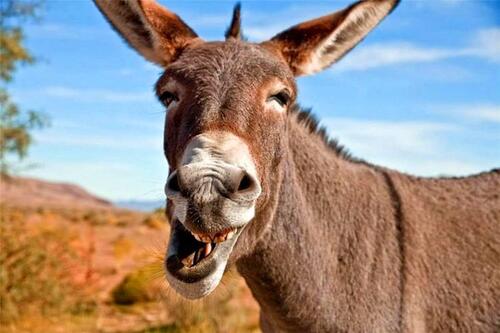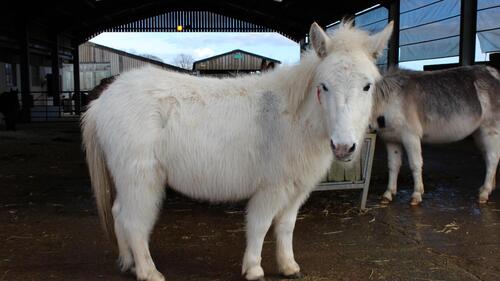Mule
IUCN
LCBasic Information
Feature
Infertility
Distribution and Habitat
All over the world, including Asia, Africa and Europe
Appearance
The mule has a compact and well-proportioned appearance, solid muscles, tight and elastic skin, shiny fur, and dark stripes on the back and the middle of the limbs. The mule has a large head and long ears, a long and strong neck, a good connection between the neck and shoulders, well-developed tendons in the limbs, and small hooves.
Details

Mule (scientific name: Equus ferus × asinus, foreign name: Mule) is the offspring of a donkey and a horse, also known as a horse mule or donkey mule. The offspring of a male horse and a female donkey is called a donkey mule, also known as a hinny, or "hinny" in English. Because the genes of a female horse and a male donkey are more likely to combine, most mules are horse mules. A horse mule is more like a horse, while a donkey mule is more like a donkey. Generally, it can live to about 35 years old. If it is well raised and managed, it can reach 50 years old and can be used for up to 20 years.
Horse mules have hybrid advantages and are horse-like in size. They have a larger body, smaller ears, and thick black hair on their tails. They are strong and have a longer lifespan than horses or donkeys.
Donkey mules are resistant to roughage, have strong adaptability and disease resistance, and are energetic and persistent, but not as good as horse mules. They are mainly distributed in North China.
It is recorded that the northern ethnic minorities of China discovered mules in the Xia and Shang dynasties around the 16th century BC, about 1,000 years earlier than foreign countries (ancient Greece). Mules were introduced into the mainland during the Spring and Autumn and Warring States periods as draft animals. The development of the mule industry in the Central Plains region is basically from scratch, from few to many, rising in a straight line and booming. Not only has it become an important working livestock in China since the Qing Dynasty. In the world, China is also the country with the most mules.

Smaller than a horse and larger than a donkey, with longer ears than a horse and shorter than a donkey. The appearance is compact and symmetrical, and the body is balanced and stable. The body muscles are solid, mostly black, the hip height is about 1.55 meters, and the weight is 540-725 kg. The mule has a slightly larger head, a short and thick head, long ears, dry mane, large and bright eyes, large nostrils, square mouth, wide jaw, neat upper and lower teeth, and a throat structure that is closer to that of a donkey. Its nasal cavity is smaller than that of a horse, its limbs are thin, its hooves are narrow, its mane is short, and it has no chestnut (keratin growth) hooks. In height and body shape, long neck and croup teeth, it looks like a horse. It is generally believed that the skin of mules makes them more capable of resisting sunlight and rain and fierce impacts.
The skin of mules is tight and elastic, and the coat is shiny. Its mane and tail are longer than those of horses, and there are dark stripes on the back and the middle of the limbs. Its hair color depends on the hair color of the parent horse.
Mules have similar habits to horses and donkeys, and their nerve types are relatively balanced. They like to watch new things. They are more gregarious than horses, but their temperament is more stubborn; if they are not trained and managed properly, they are easy to develop bad habits. Mules have poor cold tolerance, heat resistance, rough feed tolerance, hard work tolerance, and strong adaptability.
Mules inherit the sensitivity of horses and the stubbornness of donkeys. When encountering danger, the reaction type of mules is between horses and donkeys. They will be alert first and then take defensive actions. If the danger is not eliminated, mules will have explosive reactions and may show violent behavior.
Mules are generally well-proportioned in structure and can be used for carrying, pulling, and riding. Mules are short, with strong backs and waists, uniform speed, steady steps, and strong endurance. They are good at walking on mountain roads and suitable for carrying. Although the running performance of mules is not as good as that of horses, their pulling power is greater than that of horses of the same weight, and their normal pulling power is about 18%-20% of their body weight.
They feed on grass and leaves. The amount of food consumed by mules is greater than that of donkeys but less than that of horses, about 20% less than that of horses. Mules have a 10% higher digestion capacity for feed than horses, and when working, mules have an 8% higher digestion rate for dry matter in feed than horses. Mules also drink less water than horses. An adult mule needs about 15-30 liters of water a day, while horses generally need 30-50 liters.
The conception rate of male donkeys mating with female horses is higher, while that of male horses mating with female donkeys is lower, and donkey mules are prone to dystocia, so it is more reasonable to use large donkeys and purebred mares to produce horse mules.
Since horses and donkeys have different numbers of chromosomes, horses have 32 pairs and donkeys have 31 pairs, so the chromosomes of their offspring mules are 63. Male mules are infertile because their spermatogonia cannot divide normally, and they often have no sperm or all sperm are dead. Although some female mules can give birth to foals, only 50 foals were found to be born by female mules in the past 200 years.
The estrus period of female mules is similar to that of mares, and the estrus performance is also more obvious. Some female mules have ovarian atrophy or even completely lose their sexual activity function, while some have normal development of reproductive organs such as ovaries, fallopian tubes, uterus, vagina, etc., so some female mules have follicles on their ovaries during the estrus season and can discharge mature eggs. The content of estrogen in follicular fluid can reach a certain amount in the female body. Because both male mules and female mules have estrus performance. In order to facilitate training and service, male mules should be castrated at the age of 2 years old.
Mules are the product of distant hybridization and have significant hybrid advantages in growth and development. They grow and develop quickly and mature early. Therefore, at every stage of development, they develop faster than donkey foals or foals born from the same species. They can be used lightly at around 2 years old and fully mature at 4 years old. They have a long lifespan, which can reach more than 30 years, and the service period can reach 20 years.
The endurance value is off the charts. Many people regard mules as their main vehicles and let them carry goods for themselves, which significantly improves labor productivity and reduces the workload of humans.
Establish a work schedule for mules and abide by the hygiene rules for mules. First, use them according to their ability and prevent excessive fatigue. Second, pay attention to the combination of labor and service and post-service care. If there are abrasions or hoof injuries, they should be treated in time. Third, determine the service according to the animal and make reasonable matching. Fourth, increase effective working time and reduce the waste of useless work.

Disease prevention and control
The incidence of lumbar disease, osteoma, and cleft hoof in mules is much lower than that of horses, and they rarely suffer from lymphangitis. They are susceptible to many of the same diseases as horses. Many common horse diseases can be prevented by vaccination and good management measures. Mules, like their horse relatives, should be vaccinated to prevent common diseases such as sleeping sickness, West Nile disease, and tetanus.
Hemolytic disease of newborn mules is a common disease, also known as hematuria in newborn foals. It is an acute disease of mules, characterized by rapid onset, severe illness, severe anemia, yellow pox, and sometimes hemoglobinuria. The disease has a high mortality rate. If not treated in time, death often occurs within 3 to 5 days of onset. Blood transfusion therapy and decoction can be used.
Mules are susceptible to parasites. Parasites carry diseases and cause skin irritation and mental distress to mules. Using anthelmintics after combing the hair can reduce the irritation of parasites. Including flies, mosquitoes, ticks and lice.
Mules generally do not need to be shoed. Their hooves are relatively high and narrow, more flexible and tougher. They are less likely to split and break. Mule hooves should be kept clean and dry and trimmed regularly. The oral health of mules should be taken seriously and checked regularly. Healthy teeth are very important for their normal eating and digestive health.
Common colic in mules is a symptom. It is mainly caused by blockage in the digestive system, resulting in accumulation of gas, liquid or feed, but there are many causes, which need to be carefully judged and treated. Common intestinal blockages are caused by parasitic infections in the body. Impaction of the colon and cecum may be caused by eating poor quality roughage or ingesting sand. Twisting of the intestine or herniation of the intestine can also cause colic and is one of the most serious forms of intestinal obstruction and usually requires surgery.







